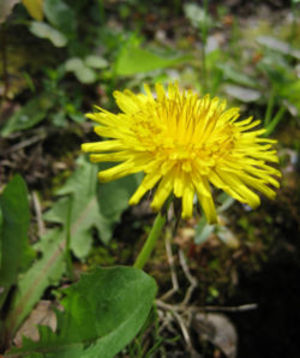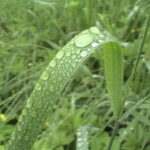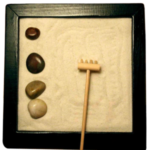Okay, so I finally got my husband to try edible flowers in some of the salads I serve him made with ingredients picked from our organic garden. He was really thrilled when I told him I was writing an article on edible weeds. I have banished him from the kitchen so he can’t see what I’m adding to the meals I prepare. After he gulps down dinner then I can tell him what he just ate. “I just ate purslane, isn’t that the stuff growing all over our paver stones in the front yard that you won’t let me spray with Round-up!?!” Yup honey, you just ate a weed salad and you’re still alive to tell the tale. His co-workers think I’m insane – they never seem to accept our dinner invitations, I wonder why?
Here are some weeds you may want to consider adding to your culinary creations. Many of these weeds can now be purchased from garden centers, either as plants or seeds, so you can grown them in your own yard if you can’t find them growing in the wild.
Burdock (Arctium lappa)
Cultivated as a vegetable in Japan where it is known as gobo. The stalks are scraped and cooked like celery. The roots can be eaten raw in salads or added to stir fries.
Cattail (Typha latifolia)
The pollen can be used to enrich flour. The unripe flower spikes can be cooked as a vegetable and the young shoots and inner stems are eaten raw or cooked.
Century plant (Agave americana)
The flower stems and leaf bases can be roasted and eaten. Certain species can be made into alcoholic drinks such as tequila.
Chickweed (Stellaria media)
Can be added raw to salads or cooked as a vegetable.
Chicory (Cichorium intybus)
The roots of this plant are used as a coffee additive. The sky blue flowers are also edible and make a terrific addition to salads.
Dandelion (Taraxacum officinale)
The flowers can be made into wine or jelly. The roots are sometimes used as a coffee substitute. The young leaves make a nice addition to salads.
Epazote (Chenopodium ambrosioides)
A tropical American weed commonly used in Mexican cooking to flavor corn, beans, mushrooms, seafood, fish, soups, and sauces.
Garlic mustard (Alliaria officinalis)
The young leaves add a mild garlic flavor to salads, sandwiches, and soups.
Goldenrod (Solidago spp.)
The leaves and flowers can be used for herbal tea.
Horseweed (Conyza canadensis)
The young leaves can be cooked as a vegetable.
Kudzu (Pueraria lobata)
AKA Japanese arrowroot. It is a prolific weed in south Florida. A starch can be made from its roots. This starch can be used to thicken sauces and gravies as you would use cornstarch. The leaves can be battered and fried.
Lamb’s quarter (Chenopodium album)
The young leaves can be added to salads.
Milk thistle (Silybum marianum)
The young leaves with the spines removed are eaten raw or cooked as a spinach-like vegetable. The flower buds can be eaten, they are like miniature artichokes.
Plantain (Plantago spp.)
The young leaves are edible if the fibrous midribs and veins are removed. The seeds are also edible.
Prickly lettuce (Lactuca serriola)
The young leaves can be eaten raw in salads or cooked as a vegetable.
Purslane (Portulaca oleracea)
Tastes similar to spinach and the leaves and stems can be eaten raw in salads or cooked or pickled in vinegar. Cooked purslane has a mucilaginous texture similar to okra.
Sheep’s sorrel (Rumex acetosella)
The young leaves can be added to salads, sauces, soups, and egg dishes.
Shepherd’s purse (Capsella bursa-pastoris)
Has been used as a food for thousands of years. The seed pods have a peppery flavor and can be used as a seasoning.
Stinging nettle (Urtica diocia)
The cooked young leaves can be eaten like spinach, added to soups and egg and vegetable dishes. Do not consume raw leaves, they are covered with highly irritating hairs thus the name STINGING nettle.
Edible Weed Salad
3 cups mixed greens such as lettuce, spinach, kale, Swiss chard.
1 cup mixed weeds such as:
-dandelion leaves
-chicory leaves and flowers
-chickweed leaves and flowers
-lamb’s quarters leaves
-purslane stems and leaves
-shepherd’s purse leaves
Toss all the ingredients together in a large bowl along with olive oil, vinegar, salt, pepper and a few to many crushed garlic cloves depending upon your personal preference. Make sure you use the young, tender leaves of any weeds you will be adding to your salads and other culinary creations. Older leaves tend to turn bitter, tough, and stringy.
Caffeine Free Coffee Substitutes
The roots of both chicory and dandelion can also be used as a caffeine free coffee substitute or coffee additive. Harvest the roots, wash well to remove dirt then cut them into small, thin slices. Place these slices on a cookie sheet on the lowest setting in your oven until they are dry or use a food dehydrator if you own one. If you are using the roots for medicinal purposes once the roots have been dried and have cooled down to room temperature they can be placed in dark glass containers and stored away from direct sunlight.
If you are using the roots as a coffee substitute the dried roots must be oven roasted at approximately 250 degrees for 30-40 minutes so that they obtain a coffee-like appearance and taste. The oven roasted root pieces can then be ground up in a blender or coffee grinder then made into coffee using your favorite method of brewing (i.e. drip coffee maker, French press, etc…) You may also make a coffee blend by mixing around 50% coffee beans with either 50% roasted chicory or roasted dandelion roots.
Medicinal Uses of Weeds
All of the weeds mentioned in this article serve double duty by also exhibiting many medicinal properties. Here are a few medicinal weeds you may want to consider using for their healing properties:
Dandelion is a bitter-sweet, cooling herb with diuretic and laxative effects. It also stimulates liver function and improves digestion.
Horseweed is a slightly aromatic bitter tonic that acts as a diuretic and checks bleeding.
Kudzu is a sweet, cooling, tonic herb that increases perspiration, relieves pain, relaxes spasms, lowers blood pressure, and soothes the digestive system.
Milk thistle is a bitter, diuretic, tonic herb that regenerates liver cells, stimulates bile flow and relaxes spasms.
Plantain (P. psyllium) contains up to 30% mucilage, which swells in the gut, acting as a bulk laxative which also soothes irritated membranes.
Purslane is rich in Omega-3 fatty acids that can help to reduce one’s cholesterol levels.
Sheep’s sorrel is best known as an ingredient of Essiac, a native American anti-cancer remedy.
Safety Precautions
When using any type of plant material moderation is key. Ingesting too much of even the most benign substance can cause you to become ill.
Never harvest weeds from the side of the road. These plants may be contaminated from vehicle exhaust fumes.
Never harvest weeds in the wild unless you are absolutely certain of their identification and you have the permission of the land owner and you know that the field hasn’t been sprayed with any harmful chemicals.
The safest way to harvest weeds is to look in your own yard. I have purslane growing allover my yard but I had to purchase seeds to establish my patches of chicory and dandelion which I planted in my garden next to my other herbs and vegetables.
Always practice organic gardening techniques in your garden especially when it’s food you intend to eat.
Sources
Edible Wild Plants, Peterson Field Guides. Houghton Mifflin Co.
Guide to Edible Weeds. James A. Duke. Random House, 1999.
Handbook of Edible Weeds, James A. Duke. CRC Press, 2001.
Herbal Remedy Gardens, Dorie Byers. Storey Books, 1999. Includes a section on edible weeds.
Wild Foods for Every Table, Compiled by Tina Sams. The Sibling Group, 2006.
Smythe, Lynn. Wonderful World of Weeds.” Posted to the Old Fashioned Living website November 2004.
Smythe, Lynn. “Wonderful World of Weeds.” January/February 2005 issue of The Essential Herbal, pages 24-26.
In conclusion, let’s give thanks to nature’s bounty of useful and nutritious edible weeds!





